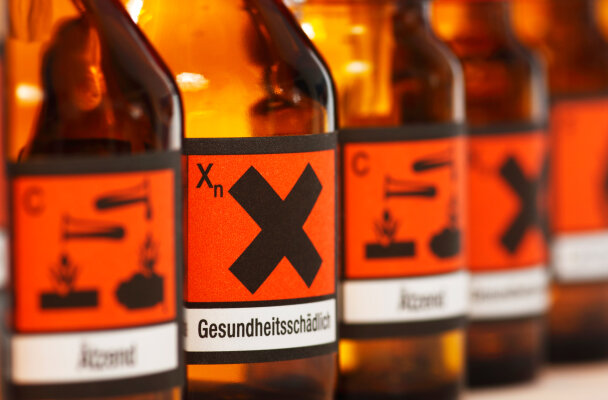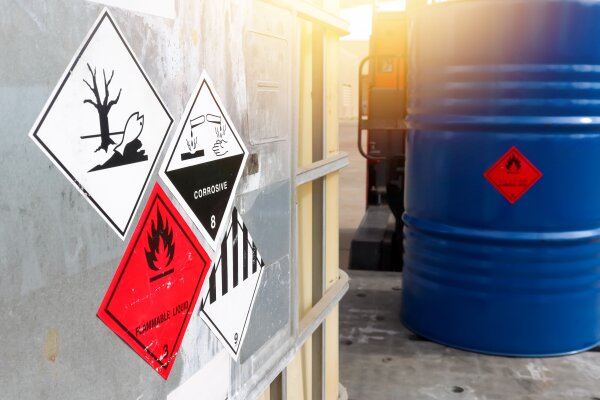Toxic substances: What are the toxic substances?
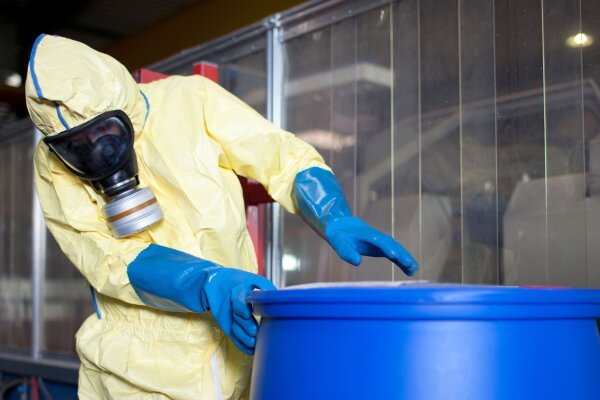
In everyday life, we come into contact with a variety of substances and materials that can have an effect on our bodies. However, some of them harm us – for example, those that belong to the category of toxic substances. How toxic substances are defined, which substances belong to them and what to look out for when labeling and handling them is summarized in this blog post.
Definition: What are toxic substances?
When we speak of toxic substances or poisons, we are talking about substances with a damaging effect on the metabolic processesof living organisms. These substances are absorbed by touch and by penetration into the body and release negative physiological mechanisms. The science that deals with toxic substances is toxicology.
Subdivision of toxic substancesNot all poisons are the same: as hazardous substances, toxic substances are divided into further subcategories according to their effect on the human organism. The terms "very toxic", "toxic" and "harmful" are used as subdivisions: Very toxic substances (T+): Very toxic substances are substances that can cause death or chronic damage to health if swallowed, inhaled or in contact with the skin, even at very low levels of intake. Examples include heroin and nicotine. Toxic substances (T):Toxic substances are also not harmless. However, their risk by definition refers to "low intake" instead of "very low intake" as in the case of very toxic substances. Here, therefore, a small amount can lead to death or chronic damage to health. Good examples here are tetrachloromethane or methanol. Harmful substances: In contrast to the other two categories, harmful substances do not lead directly to death, but "only" cause acute or chronic damage to health. An example of such toxic substances is potassium chlorate. Speaking of hazardous materials: Detailed information on this topic is summarized in the blog post "What are hazardous materials?". |
In what way do toxic substances act?
Depending on the substance, toxic substances can have very different effects on the human body. However, they usually attack receptors in the organism, which in turn are foundin various organs. Poisons can also be categorized according to this subdivision:
- Hepatotoxins: Lead to acute poisoning of the liver (e.g. paracetamol).
- Nephrotoxins:Lead to acute poisoning of the kidneys (e.g. heavy metals).
- Neurotoxins:Lead to acute poisoning of the nerves or brain (e.g. botulinum toxin).
- Respiratory depressant toxins: Attack internal respiration and block the cells of the respiratory chain (e.g., carbon monoxide).
When exposed, the toxic substances accumulate at the receptors of the corresponding cells and block them, so that the body's own important enzymes, ions and messenger substances can no longer act there. This causesthe cells to stop functioning, which in turn affects and damages the organ. The actual toxicity is influenced by factors such as age, body weight, and general physical condition.
Toxic behavior at the receptors can be divided into two types: Concentration poison and summation poison. While the former (e.g. nicotine) increases in effect with increasing concentration of the toxic substance, summation poison causes an irreversible change in the receptors (e.g. benzo[a]pyrene).
Very toxic substances: list of 10 strong poisons
Although the handling of toxic and very toxic substances has become less dangerous due to legal requirements and safety precautions, the high toxicity of these substances must not be forgotten. For example, some chemicals areso toxic that only designated specialistsshould work with them. For very toxic substances, the following representatives of toxic substances can be mentioned as examples in particular:
Botulinum toxin
Botulinum toxin is considered the most toxic substance in the world and is produced by bacteria of the genus Clostridium. The toxin triggers a so-called "botulism" in living creatures, which corresponds to a very severe and often fatal food poisoning. Botulinum toxin belongs to the group of neurotoxinsand can be found in spoiled meat products. Incidentally, the neurotoxin Botox, which is used in the beauty industry, is an extremely diluted version of botulinum toxin.
Aflatoxin B1
Aflatoxins are produced by molds of the genus Aspergillus and belong to a group of about 20 substances. The most dangerous for humans is aflatoxin B1, which reacts in the body to form a highly toxic metabolite - epoxide. This in turn triggers lung cancer and hepatocellular carcinoma. This makes it one of the most carcinogenic poisons of all. Aflatoxin B1 is found in mold spores.
Dimethylcadmium
Dimethylcadmium is a very volatile heavy metal that is easily inhaled and leads to extreme effects. Especially under the name "dimethylmercury" it is known worldwide as an environmental toxin. Dimethylcadmium is not only highly carcinogenic, but also damages the liver and all parts of the body that come into contact with it. Death from this substance is usually renal failure.
VX
VX is an abbreviation standing for the substance 2-[(diisopropylamino)ethyl]-O-ethylmethylphosphonothioate. It was developed as a chemical nerve agent from the pesticide amiton and has been used repeatedly as a warfare agent in the past. The lethal potential results from even slight contact with the skin. VX inhibits the enzyme acetylcholinesterase in the body, causing muscle paralysis with respiratory failure.
Nickel tetracarbonyl
This carcinogenic liquid is a combination of nickel and carbon monoxide that can be lethal. This toxin already evaporates at room temperature, so that absorption via the lungs is possible quickly. But nickel tetracarbonyl can enter the body not only as an inhalation poison, but also through the skin. There it attacks the iron in the hemoglobin.
Selenophenol
Selenophenol has a similar effect to mustard gas and produces blisters on the skin when touched. These not only heal with difficulty, but also leave residues of the toxin under the top layer of skin. Nevertheless, it is possible to buy selenophenol in free trade. Due to the chemical proximity to sulfur, the typical odor is given.
Cyanide
Cyanide has become a household name at least since the James Bond films. This is potassium cyanide, i.e. the potassium salt of hydrocyanic acid. An intake dose of 140 milligrams is already lethal for humans. The poison is usually recognizable by a bitter almond odor.
Arsenic
Arsenic is produced during the extraction of gold, lead and copper. Like cyanide, it has a lively past and was already used in the Middle Ages for poison attacks. Arsenic has high toxicity and impairs THEN repair, so that cellular energy metabolism is disrupted. However, in some medicines it is used for exactly these purposes.
Tetrodotoxin
Tetrodotoxin is the reason why a puffer fish must not be prepared privately: this toxic substance is therefore also known as puffer fish poison. In chemistry, it goes by the abbreviation TTX and is used in small doses as an analgesic. This toxic substance belongs to the neurotoxins and acts particularly quickly.
Batrachotoxin
Batrachotoxin, which is produced in the body of the "Terrible Poison Dart Frog", is considered the third most toxic substance in the world. Although this neurotoxin has no effect on the skin, it can enter the bloodstream from even minor injuries and be lethal. The substance inhibits theinactivation of sodium channels, which leads to a long-lasting spasm.
Dangerous goods class 6: Toxic and infectious substances
In order to be able to classify dangerous goods for transport according to hazard characteristics, they are assigned to different dangerous goods classes. These range from dangerous goods class 1 to dangerous goods class 9. Poisons and toxic substances are found in class 6, which in turn is composed of two subcategories:
Dangerous goods class 6.1
Class 6.1 is by definition the only one that groups together substances that are actually toxic. It islabeled with a skull and crossbones symboland includes substances that "may cause damage to the health or death of a human being after inhalation, ingestion or contact with the skin in single or brief exposure in relatively small quantities." The classification is based on experience or animal studies. Examples include hydrogen cyanide and arsenic.
Dangerous goods class 6.2
Class 6.2, on the other hand, includes infectious substances "known or suspected to contain pathogens known or suspected to cause infectious diseasesin animals or humans." These include microorganisms such as bacteria, fungi or viruses. Dangerous goods class 6.2 is further subdivided into:
- Category A:(life-threatening or fatal course of the disease) and
- Category B:(non-life threatening or non-fatal course).
Labeling of toxic substances according to GHS
The Globally Harmonized System of Classification and Labeling of Chemicals (GHS) specifies uniformly worldwide how hazardous substances are to be labeled during transport. The labeling system is based on the CLP Regulation (Regulation (EC) No. 1272/2008), which has been in force since 2009 and is regularly updated. In addition to pictograms, toxic H-phrases are also prescribed there.
Pictogram
Pictograms are understood to be hazard symbols that are often accompanied by a warning in the form of a signal word (such as "Danger" or "Caution"). The pictograms for toxic substances correspond to the above-mentioned subdivision into very toxic, toxic and harmful, whereby the symbol for toxic does not differ from that for very toxic:
| Pictogram | designation |
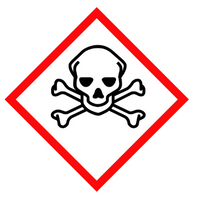 |
Very toxic |
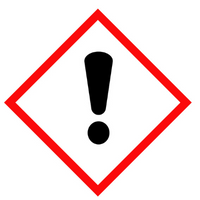 |
toxic |
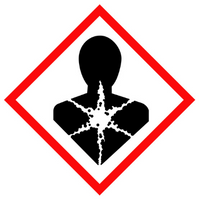 |
Harmful to health |
H-phrases
In addition to the pictograms, so-called H-phrases are also prescribed, which allow a more precise classification of the hazard posed by the transported substance. These are short sentences with safety information, which are based on the hazards of the chemical substance or its preparation. Three subdivisions can be mentioned for H-phrases:
- H200 series: Physical hazards (e.g. H201: Explosive, mass explosion hazard).
- H300 series:Health hazards (e.g. H301: Toxic if swallowed or H311: Toxic in contact with skin).
- H400 series: Environmental hazards (e.g. H411: Toxic to aquatic organisms with long lasting effects).
EUH rate
In addition to the H-phrases, EUH-phrases are also used in the EU. Typically, these are phrases that were previously defined as R-phrases and were dropped during the negotiations for the GHS. With regard to toxic substances, these EUH phrases can be mentioned as examples:
- EUH029: Contact with water liberates toxic gas
- EUH031:Contact with acids liberates toxic gas
- EUH032: Contact with acids liberates very toxic gas
- EUH070:Toxic in contact with eyes
Toxic substances: examples of poisons in everyday life
Not only at the workplace or in the hospital, but also in everyday lifewe constantly encounter toxic substances. While some are consciously integrated into our daily lives, we encounter others quite unconsciously over and over again. Here the following toxic substances can be mentioned as an example:
- Triclosan:This is an antibacterial preservative that can be found in liquid soaps or deodorants, for example. However, it has sperm-damaging and breast cancer-promoting effects and can trigger allergies.
- PVC: It is not uncommon for floors made of PVC to contain heavy metals and plasticizers as stabilizers. These toxins have a negative effect on the human organism and can enter the respiratory tract via indoor air or house dust. But plasticizers can also be found in many other plastic items - from water bottles to rubber boots.
- Zusatzstoffe für Lebensmittel: Konservierungsstoffe, Farbstoffe und aromatische Zusätze gehören zu vielen Fertiglebensmitteln dazu. These substances also have a toxic effect in high concentrations and can cause rashes, respiratory problems and irritation.
Handling toxic substances: Regulations and ordinances
In order to make the handling of toxic substances as safe as possible, a number of important regulations and ordinances have been enacted by the legislature. These cover various areasranging from hazard assessment and labeling to storage and occupational safety. In particular, the following specifications must be observed:
Production, evaluation and distribution according to the Chemicals Ordinance
When it comes to the manufacture, evaluation and distribution of toxic substances, the European Chemicals Regulation (REACH = "Registration, Evaluation, Authorization of Chemicals") sets the tone. To fulfill the obligations of this regulation, companies must identify the risks of the toxic substancesand notify ECHA (European Chemicals Agency).
REACH prescribes how information on poisons must be collected and assessed. The individual registrations to ECHA lead to anevaluation there regarding conformitywith other notifications.
Classification and labeling according to GHS
The classification of the risk posed by a toxic substance forms the basis for the correct labeling. The GHS labels described earlier in this blog post are used for this purpose. Thus, each toxic substancemust be labeled with a pictogram as well as an H and an EUH phrase (if applicable). These hazard warnings are elementary for both transport and storage.
Storage according to TRGS 514
Legal regulations also apply again to storage, compliance with which must be ensured. The storage of "very toxic and toxic substances in packaging and portable containers" is prescribed in TRGS 514 (Technical Rules for Hazardous Substances). In addition to specifications forventilation and storage areas, there are rules regarding placement (think of cabinets for hazardous materials, for example).
Occupational safety according to the Ordinance on Hazardous Substances
In addition, there isthe Ordinance on Hazardous Substances (GefstoffV), which prescribes, for example, the subdivision into dangerous goods classes 6.1 and 6.2. It provides regulations on how to deal with hazardous substances in everyday working life - from the need for a safety officerto maxims for action by first responders in the event of contact with a toxic substance.
Toxic substances: proper storage is essential
Toxic substances can have extreme physical consequences, which is why trained handling and optimal adherenceto safety precautions are essential. In addition to recognizing these substances, this also includes appropriate labeling and storage.
Do you have questions about the topic or would you like to suggest a topic? Feel free to contact us by phone at +49 30 2096579 00 or send us an email at info@medsolut.com

